Rules for selecting a leveling mixture for the floor + examples of its correct application
Uneven floors are a problem that often occurs not only in old buildings, but also in new homes. Of course, laying tiles, laminate, parquet and other floor coverings will have to be delayed, because you must first level the floor. Leveling mixes for the floor are an excellent material with which this procedure is accelerated and the quality of the final result is improved. Why? Because the modifiers that make up such mixtures have good adhesion, elasticity and excellent self-leveling ability.
What should be included in the mixture?
Often, the basis for a leveling mixture is well-known cement. And also it can be gypsum, then the color of the screed turns beige or light cream. This feature can scare unprofessional builders, but there is nothing strange, the color is normal.
Another feature can be called the addition of special additives, they increase the ductility of the material, fluidity. Moreover, some blends may contain synthetic fibers. Due to the fact that the composition of the mixtures is specific, the appearance of cracks and microcracks in the screed becomes unlikely. Of course, if you follow all the instructions and the shelf life of the mixture does not exceed three months.
Important: if the material is expired, the screed will work, but it will already have deteriorated characteristics.
Types of mixtures and their features
As for the classification, the mixtures in question can be leveling and self-leveling, which in turn are used to apply the initial or finish layer.
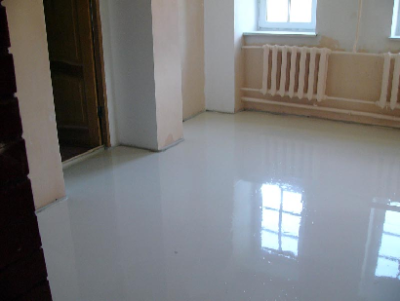
The difference between the mixtures is the way they work. For example, self-leveling mixtures spread almost without human intervention. If the room has an impressive size, the mixture is poured using pumping devices, that is, pumps. But the leveling mixtures require active participation: they must be smeared with a spatula manually. This means that self-leveling mixtures are more fluid.
If you consider this issue more carefully, you will notice that the self-flowing compounds harden quickly and are intended for leveling, leveling the bases. Their main purpose is to prepare floors, for example, from concrete, wood, gypsum for the subsequent installation of carpet, cork, linoleum, and ceramic tile.
After drying of such a bulk floor, a strong, dense layer is formed. It should be understood that this base cannot be used without flooring. This is due to the fact that an unprotected surface has a tendency to absorb oils, water, and it also dusts.
When the mixture hardens, significant stress is not created, but when applying a thick layer in a room with a large area, experts recommend laying a foam cord around the entire thickness of the layer around the perimeter. Many manufacturers take this point into account, therefore they produce mixtures for finishing and for rough leveling of too uneven surfaces. But mixtures for applying a thick layer have a reduced fluidity, and this does not guarantee the final obtaining of an ideal floor. Therefore, then you will need to apply an additional finish coat.
Can it be used for a wooden base?
If the house has flooring, consisting of old, warped boards, the situation can still be saved by choosing the right leveling compound. The plank base is covered with a mixture, after drying, the layer hardens, a smooth, flexible and at the same time strong base is created for the installation of a new coating. But just before applying the mixture, you need to carefully prepare the base, attaching the boards to the beams, sealing the seams with an acrylic mass and covering the floor with a special moisture-proof primer. And also on a primed base, it is necessary to lay a reinforcing mesh, which is attached using a stapler. Nothing complicated, but the result is wonderful.
In addition, the screed obtained from the leveling mixture has several advantages:
- increased strength;
- lack of shrinkage;
- low abrasion;
- good adhesion to the substrate;
- environmental friendliness - natural components are used to make mixtures;
- ease of laying and relatively quick drying;
- after installation, no additional steps are necessary, this applies to watering, shelter with a film.
Laying steps and work tips
First you need to carry out preliminary preparation of the foundation. To do this, the surface is cleaned and dusted with a vacuum cleaner. Then the joints of the plates and cracks are covered with a repair mixture.
Important: traces of bitumen mastic that may remain after the dismantling of the old coating must be covered with expanded clay sand (large fraction).
After that, the surface is primed, and beacon profiles are installed on the floor, they serve as peculiar levels for setting the layer thickness.
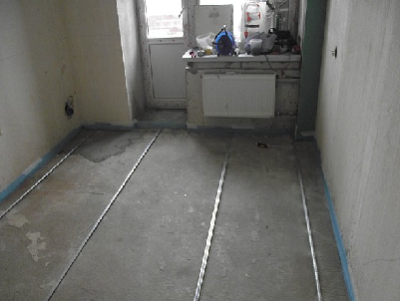
The slats are installed so that their top matches the marks indicated on the wall. In fact, specialists do not use profiles because they can display horizontal lines without them. But if self-taught does the screed, it is better to use beacons to improve the quality of work.
Directly to prepare the mixture you will need a large bucket in which the mass is mixed with water (a drill with a nozzle). At this stage, the manufacturer's recommendations should be strictly observed, since an excessive amount of water will lead to delamination of the material, of course, not without loss of strength characteristics.
The finished mixture is poured onto the prepared base, irregularities are filled up to the beacons. Then with a spatula or rule, the solution is finally leveled. The bubbles arising in the material are removed with a needle roller.
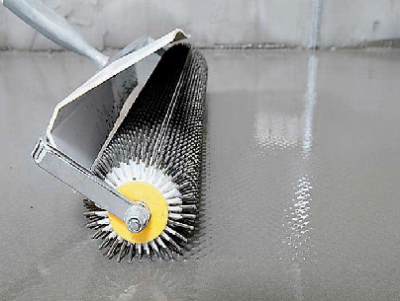
The first few days, it is advisable to adhere to the temperature regime specified by the manufacturer, avoiding drafts.
Due to the fact that leveling mixtures have a large number of advantages, they are widely used in construction. The main thing is to comply with the technology, then the floor will be perfectly aligned.

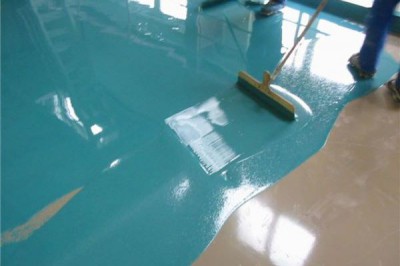
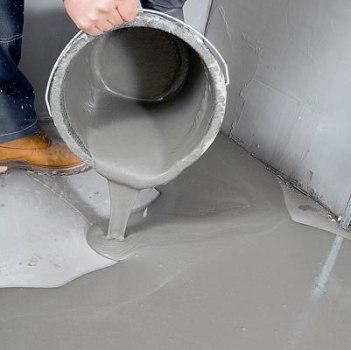
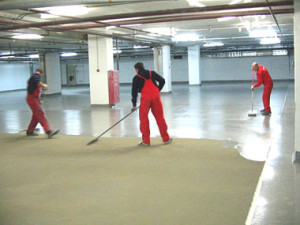
3 comments